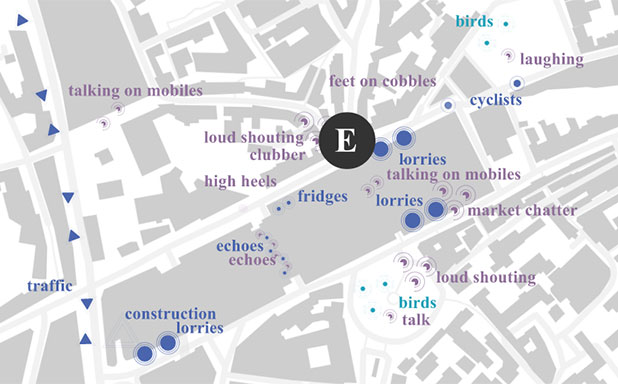From the 3am clatter of delivery lorries and clubbers heading home to the intermingling whiff of raw meats and coffee from the 24-hour coffee shops, a series of digital maps completely nail Smithfield Market.
The fascinating maps are designed to spark debate about The Museum of London’s planned move into the centuries-old West Smithfield site by 2022.
A team from Brunel University London worked with a digital consultant to capture the market’s distinctive feel through photographs, sound recordings and streetscape studies.
The idea is to make people prize the grit, creative edginess and history of the area now the UK's largest wholesale meat market and once a site for public executions.

Screenshot of animated, interactive sensory map, available at SensorySmithfield.com
The Farringdon market buildings feature some stunning Victorian architecture, such as spectacular roofs and columns designed by Sir Horace Jones – the architect behind Tower Bridge, Billingsgate Market and Leadenhall Market.
Future talks about the museum’s £250 million move into the abandoned general market building should look to what makes the market unique, says study leader Dr Monica Degen.
“While there is a great sense of optimism, there is also a deep sense of concern about whether the regeneration will irrevocably change the feel of the area,” she said.
“There is a strong sense of nostalgia about the market and its place in London history, and a general agreement this regeneration should be sensitive to the needs of the area.”
The researchers focused on four streets – Long Lane, Lindsey Street, Charterhouse Street and Farringdon Road – where they spoke to hundreds of people like office workers, residents, market workers, visitors, cab drivers and couriers. The academics wanted to bring to life how Smithfield attacks the senses and look at how different people experience it.
Their maps come from a detailed study that suggests museums play an important part in debates about regeneration, through their collections and community standing. Alex Werner, Lead Curator of New Museum, Museum of London, said: “This report on the sensory identities and temporal flows of the area will be a very valuable resource as the museum develops its interpretation masterplan, setting out its vision for programmes, display areas and public spaces both within and in the environs of its buildings.”
(Image: CC by flickr/davidedamico)
Reported by:
Hayley Jarvis,
Media Relations
+44 (0)1895 268176
hayley.jarvis@brunel.ac.uk